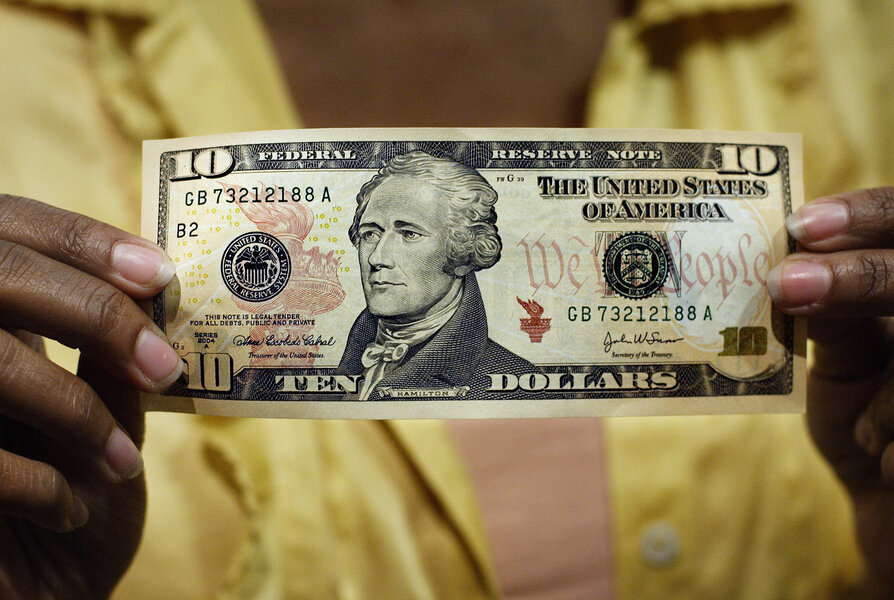'Hamilton' may have saved the $10 bill, but at what cost?
Loading...
US Secretary of the Treasury Jack Lew may announce a major change in plans for the $10 bill and its planned revamp this week.
Although the Treasury has not officially commented, Secretary Lew hinted at the changes this week, remarking on how invested many Americans had become in the bill redesign since it was announced last summer.
"We're not just talking about one bill," Lew told CNBC. "We're talking about the $5, the $10, and the $20. We're not just talking about one picture on one bill. We're talking about using the front and the back of the bill to tell an exciting set of stories."
It is anticipated that Lew will announce that Founding Father Alexander Hamilton (the first secretary of the Treasury) will remain on the $10 bill, while a woman would eventually grace the front of the $20 bill.
The popularity of smash-hit musical "Hamilton," about the famous Founding Father's life, may have saved Hamilton's place on US currency.
In March, "Hamilton" creator Lin-Manuel Miranda announced that big changes might be coming in the struggle to redesign the $10 bill. Mr. Miranda met with the secretary of the Treasury this March. After their meeting, Miranda announced that "Hamilton" fans would be pleased with the outcome of the talk.
"The Secretary thanked Miranda for the ingenious way in which he has been able to tell Hamilton's story," a Treasury spokeswoman told The New York Times, "and ignite a renewed interest in one of our nation’s founding fathers. Secretary Lew also reiterated his commitment to continue to honor Alexander Hamilton on the 10 dollar bill."
Yet some are conflicted about Lew's prospective announcement.
The group that initially campaigned for placing women on currency, Women on 20s, first presented a petition to President Obama and the Treasury Department one year ago.
They sought female representation on one of the most circulated bills in the world, the $20 bill. They were told they could have the $10, which was then up for redesign by 2020, the 100th anniversary of women's suffrage in the United States.
Now it looks like whichever woman the Treasury picks to grace the $20 bill, she won't been seen for at least a decade.
"The redesign of the 20 needs to be speeded up," Women on 20s founder Barbara Ortiz Howard said in a phone interview with The Christian Science Monitor. "On the face, this looks like a tremendous victory. At long last, we will see Andrew Jackson, known for his terrible crimes against native Americans, leave our currency. But between now and 2030, so much can happen."
For security reasons, the Treasury says that it cannot speed up the $20 bill redesign process.
Ms. Howard and other Women on 20s supporters feel betrayed by the Treasury's about-face. While Women on 20s always wanted to redesign the $20 bill to feature an important woman from US history instead of the $10 bill, the new timeline means that realizing their goal is still a ways off.
The Treasury has offered what it considers a fair compromise, with a mural-type depiction of several famous American women on the back of the $10 bill. The Treasury is also contemplating a $5 bill redesign, which would feature a mural-style back as well.
Redesign advocates say that the proposed mural design is not enough.
"It will take a microscope to see who those individuals are," Women on 20s wrote in an open letter to Secretary Lew, "and we'll be left with another decade or more of woefully inadequate representation of women and their worth."
Until things change, Howard says, our nation's currency teaches young girls that women's accomplishments and successes aren't equally valued as those of men. Women have been invisible so long, she says, that it is time for a woman to take a place of honor on the front of a bill.
Still, there could be a better compromise for fans of both Hamilton and female currency candidates such as Eleanor Roosevelt, Harriet Tubman, or Rosa Parks.
"There is a way to honor both Hamilton and a woman, and dovetail with our centennial," Howard said by phone, "and that would be to feature both Hamilton and an extraordinary woman on the front of the bill."








